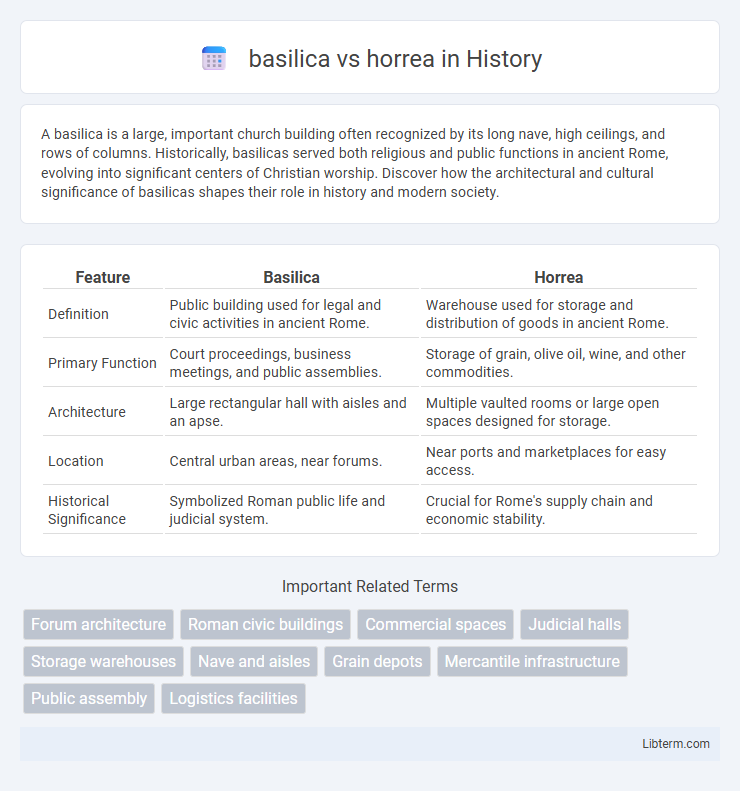A basilica is a large, important church building often recognized by its long nave, high ceilings, and rows of columns. Historically, basilicas served both religious and public functions in ancient Rome, evolving into significant centers of Christian worship. Discover how the architectural and cultural significance of basilicas shapes their role in history and modern society.
Table of Comparison
| Feature | Basilica | Horrea |
|---|---|---|
| Definition | Public building used for legal and civic activities in ancient Rome. | Warehouse used for storage and distribution of goods in ancient Rome. |
| Primary Function | Court proceedings, business meetings, and public assemblies. | Storage of grain, olive oil, wine, and other commodities. |
| Architecture | Large rectangular hall with aisles and an apse. | Multiple vaulted rooms or large open spaces designed for storage. |
| Location | Central urban areas, near forums. | Near ports and marketplaces for easy access. |
| Historical Significance | Symbolized Roman public life and judicial system. | Crucial for Rome's supply chain and economic stability. |
Introduction: Defining Basilicas and Horrea
Basilicas in ancient Rome were large public buildings primarily used for legal proceedings, commercial transactions, and social gatherings, featuring expansive halls with rows of columns and a central nave. Horrea, by contrast, served as warehouses designed for storing grain, goods, and other commodities crucial to urban supply chains, characterized by robust, secure construction and multiple rooms for organized storage. Understanding these distinct architectural functions highlights their pivotal roles in the social, economic, and administrative infrastructure of Roman cities.
Historical Origins of Basilicas and Horrea
Basilicas originated in ancient Rome as large public buildings used for legal and other civic proceedings, evolving from Greek stoas around the 2nd century BCE. Horrea were Roman warehouses designed for storage of grain, olive oil, and other goods, supporting urban supply and trade from the Republican period onwards. Both architectural forms highlight the organizational complexity of Roman public and economic life, with basilicas serving social and judicial functions and horrea ensuring resource distribution.
Architectural Features: Basilica vs Horrea
Basilicas feature a longitudinal layout with a central nave flanked by aisles, often topped with clerestory windows to allow natural light, and an apse at one or both ends serving as a focal point for public gatherings or legal proceedings. Horrea are characterized by a more utilitarian, rectangular floor plan with robust, thick walls and multiple storage rooms designed for the secure preservation of goods, incorporating small windows or ventilation openings to maintain air circulation. Architectural elements in basilicas emphasize grandeur and openness, while horrea prioritize security and functionality.
Primary Functions and Uses
Basilicas primarily served as multifunctional public buildings in ancient Roman cities, used for legal matters, commercial activities, and civic gatherings, often housing courts and marketplaces under one roof. Horrea were specialized warehouses designed for the storage and preservation of goods such as grain, olive oil, and wine, featuring robust construction and secure environments to protect valuable commodities from spoilage and theft. Both structures played crucial roles in the economic and administrative functioning of Roman urban centers but differed significantly in purpose and architectural design.
Social and Economic Importance
The basilica served as a central hub for social interaction and legal activities, facilitating commerce through its function as a marketplace and a courtroom in Roman cities. Horrea, on the other hand, were vital for economic stability, acting as warehouses that ensured the storage and distribution of grain, olive oil, and other essential goods. Both structures contributed to the urban economy: basilicas as centers of transaction and public gathering, horrea as secure facilities supporting trade and food supply chains.
Location and Urban Placement
Basilicas were typically situated in the heart of Roman forums, serving as central hubs for legal and commercial activities, reflecting their importance in civic life. Horrea were commonly located on the periphery of the urban core or near ports and warehouses to facilitate the storage and distribution of goods. Their strategic placement optimized accessibility for merchants and transport while minimizing congestion in central public spaces.
Construction Materials and Techniques
Basilicas were primarily constructed using durable materials such as stone, brick, and concrete, featuring large open interiors supported by rows of columns and timber or vaulted ceilings to accommodate public gatherings. Horrea, the ancient Roman warehouses, utilized robust stone and concrete walls with thick wooden beams and vaulted ceilings designed for durability and protection of stored goods. Both structures employed Roman concrete techniques, but basilicas emphasized spacious, light-filled interiors, while horrea prioritized strong, secure storage environments.
Changes Over Time and Adaptations
Basilicas in ancient Rome evolved from multifunctional public buildings into specialized spaces for legal proceedings and commercial activities, reflecting urban growth and administrative demands. Horrea, originally simple warehouses, adapted structurally over centuries to accommodate increased trade volume and improved storage techniques, including the use of stacked floors and ventilation systems. Both architectural forms demonstrate flexibility in function and design, mirroring shifting economic and social needs in Roman society.
Iconic Examples in Ancient Rome
The Basilica of Maxentius and Constantine stands as an iconic example of Roman basilicas, showcasing impressive vaulted ceilings and expansive interior space used for legal and commercial activities. In contrast, the Horrea Galbae exemplifies Roman horrea, designed as large, secure warehouses with compartmentalized storage for grain and goods, featuring thick walls and minimal decoration. Both structures reflect the architectural ingenuity of Ancient Rome tailored to distinct civic and economic functions.
Legacy and Influence on Modern Architecture
Basilicas, originally Roman public buildings, influenced modern architecture with their large, open interior spaces and clerestory windows, elements seen in contemporary civic and religious structures. Horrea, ancient Roman warehouses, contributed to the development of efficient storage design and modular construction techniques reflected in modern logistics and industrial buildings. The architectural legacy of both basilicas and horrea manifests in the balance between functional utility and structural innovation in present-day urban design.
basilica Infographic

 libterm.com
libterm.com